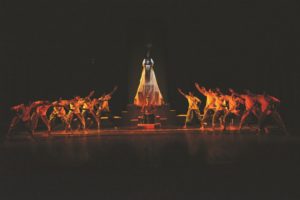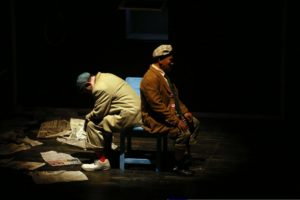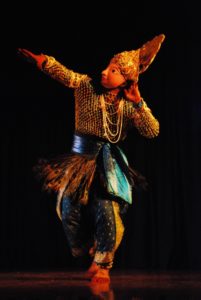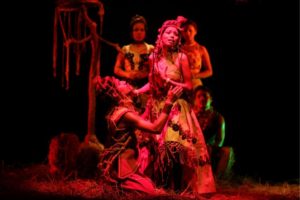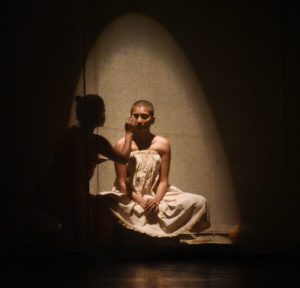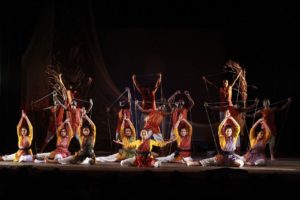AGARBATTI – THE SEXUAL INCINERATION ON STAGE – SO ARRESTING!
Sexually Explicit Content – Well, the phrase itself provokes many intelligent communities to either hide their face behind the four walls of the house or to protest against it in loud volumes. I must say, the opening scene of the play AGARBATTI -(Directed By: Swati Dubey Produced By: Samagam Rangmandal Written by Ashish Pathak, the play has bagged four awards at Mahindra Excellence in Theater Awards META)is been so intelligently devised by the director that it resists both these reactions in the most convincing manner. The scene is brutal in its explicit provocation of sexual act openly but, in spite of the same, it forces admiration for the craftsmanship that works behind making such a sensuous implication bold and yet appreciable in its own right.
Women who are the major participants of this scene inviting and enacting sexual insinuations manage to extract the susceptibility that stimulates sexual urge and receptivity towards sexual matters in the feminine gender. The most significant part of the reality about women especially those in the conservative Indian rural areas (now I am not generalizing here though) who despite being apparently uninitiated in the matters of sex, as the world knows it, display their repressed sexual urge through such innuendos. Primarily, this sort of depiction on the proscenium in front of an apparently cultured urban audience accompanies the predicament of these women being stereotyped as flagrant on account of the evident unconcern about propriety. The consideration that the lack of urban literacy in these ladies may provoke them to comply with blatant projections of the kind they choose to engage into in such private gatherings exclusively for women may or may not be the conscious level of acceptance in the midst of the educated audience. The same being represented in a rural set up amidst village audience also may not offer a neat solution for the participants. This is because, the onslaught of orthodoxy may not give it a fair chance to explain the social reality that forces the play participants to opt for such depictions that escape revering societal taboos against phenomenon like sex.
Witnessing the scene, it seems the director makes a bold choice; the one that lets him the freedom to outdo inhibitions that often mar the essence of the play despite an interesting script. That sexual acts do often have the potential to be synonymous with brutality is the implication one explicitly gathers when one watches the sexual act being symbolically represented through the means of an enactment and gives a feel of the supposed theme (Now I need to watch the play to comment more on this) this play perhaps would be dealing with coercion the women often encounter with respect to overbearing masculine tendencies. It is this very intent that makes the apparent sexual content in the scene worth watching (particularly for those that know its content) as it emblematically proclaims the reason to justify its inception on the stage. It works as a foreboding of a gruesome massacre that is perhaps supposed to occur next. However, for someone (as I) who has no knowledge of the subject matter on which the play is based nor has access to the entire script of the play, this entire scene comes as a jolt for the manner and the extent to which a sexual intercourse is celebrated elevates curiosity to construe the reason that it has been done this way. Therefore, the scene appears relevant to those that know the reason and interests those that do not know the reason for the explicit proclamation of sex in the opening scene of this drama. This (I feel) makes it a justifiable attempt in spite of its radical nature and helps it survive the jeopardy of questions or objections that accompany a presentation of such an explicit kind. When you explicitly dramatize “let’s have sex” for the people, you are required to maintain a symbolic decorum which does not exclude the need to be barefaced. This paradox is a difficult challenge and to a great extent it has been managed very well by making women participants cover their visage (full/half) with veils that douse their brazen nature in spite of its openness- and it’s supposed to be so in conventional milieu(supposedly). Moreover, the mannerisms of theirs in terms of aping a sexual intercourse are well regulated in spite of the recklessness because every time you see the actor in disguise of a man attempting to assault, there is an obvious emphasis on the mode of representing it as a part of a dramatization than a realistic event. There is a dramatized attempt, extremely effective by the women to thwart him from the shameless act.
When you witness the entire dramatization, since it appears ‘dramatic’, it convinces that it is not ruthless in spite of obviously trying to show the ruthlessness that accompanies such acts which embody forceful subjugation of women. A well balanced attempt which certainly shows how tactfully a vigilant and responsible theatre practitioner can manage the repercussions that are invariably a part of such a portrayal which intends to upset many brand ambassadors of decency and propriety. Well, admitting the fact that sobriety is an essential responsibility to be observed in artistic endeavours, I also feel that the needful depiction of violence and sex may not be essentially curbed but rather could be exposed taking full advantage of the scope that theatre offers; to dramatize the dramatic content. I felt, this scene is a vital to construe the relevance of histrionics that must be in close proximity with reality but not lose connect with the genre of “performance”. It is this distanced involvement of this scene with ‘realism’ that erases all issues pertaining to decorum instead of avoiding it entirely as a tabooed matter or criticizing its candour, watching it makes one rethink about the societal indifference towards certain realities that has ushered the need for art to penetrate into such explicit rebuttal of the so-called morality. As a result one cannot help but admire its intensity apart from anything else…therefore; the dramatized sexual havoc on stage appears so arresting!
For comments (if any) please post in the box below.
For more information on the play please visit:
Sources:
Agarbatti: The Play – http://metawards.com/plays/agarbatti
